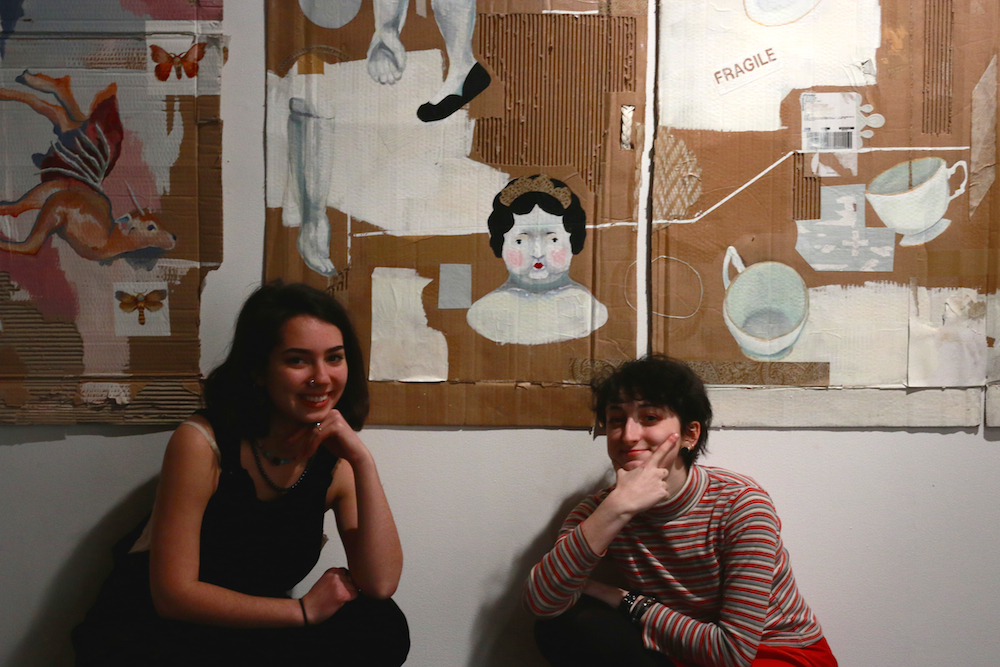Written by Leah Concepcion-Vanderbyl.
It’s 11 PM and your deadline’s tomorrow morning. You’ve had a whole month to get your act together and create something, but that “lightbulb moment” just never came and now you’re left staring at a blank canvas/document/page. Pencil in hand, you pray for inspiration to strike, but to your dismay, nothing comes out.
We’ve all been there: a creative rut. Whether you’ve been feeling blocked for a week, month, or year, most artists can relate to the dreaded sensation of drawing a creative blank. Luckily, there are also countless ways to stimulate your imagination and, to learn a few, we asked the experts: young artists. Specifically, the students from the Claude Watson arts program at Earl Haig.
This month at Twist, we’re proud to be showcasing the work of these incredibly talented art students. Featuring work from grades nine through twelve, the exhibition is not only a celebration of the dedication and talent they’ve demonstrated over the past school year, but also a testament to the remarkable level of creativity coming from these young creative minds. Figuring that we could stand to learn a thing or two from them, we spoke to a few of the participating artists during their opening night about how they tap into their creative selves and got some truly sound advice.
TIP #1: INPUT BEFORE OUTPUT
One of the most popular tips we received was to prepare for any project by looking outside of yourself for inspiration; in other words, input before output.
“I feel like a growing trend right now is honestly just going on Instagram and following artists—it’s really helpful,” said grade 12 student Vera Wang. For her piece—an ode to her favourite pen brand, Muji—she looked to the heritage and urban landscapes of Japan for inspiration and created a pen drawing that depicts five different locations where Mujis are found.
Sofie Kreidstein, also in grade 12, agreed: “I go on a sort of art binge — I don’t do that much planning ahead of time, so when I start it’s mostly just these ideas and then problem solving using other ideas, and building on top of them from there. The key is to set aside a certain amount of time in the beginning to get your materials together.”
TIP #2: JUST DO IT (PRODUCE, PRODUCE, PRODUCE)
When it comes to stimulating your creativity, a common theme among the practices of the Claude Watson students seems to be just that: practice. Levana Katz, a grade 12 student at Earl Haig, recommends just putting pen to paper as a start.
“I get blocked a lot, and I can’t always produce,” she said, “so I just try to do observational sketches and then from there—from the forms that I draw and that I like—I’ll keep developing off of that.
“I feel like the most important thing is to actually produce art,” added Ruby Zheng. “As long as you put something on paper or produce something, you will continue to improve and get some results.”
TIP #3: BE SUBJECTIVE
After speaking with Brennan Lu about his conceptual piece, featuring a series of pen lines that illustrate the depletion of his own pen’s ink over time, it became apparent just how important it is to trust in your own subjectivity while starting any creative work.
“I was given only a blue pen to use for this project, so I decided to do a more conceptual work and focus on the pen itself and the ideas that it brought to my mind,” said Brennan. “The main idea that it brought up for me was manufacturing, because blue pens are so common in office jobs. Creating the piece was just drawing a lot of lines… a lot of lines. It was supposed to mirror that monotonous, manufacturing process.”
His advice? Though it’s helpful to try and think objectively in the revision period, one of the best ways to find inspiration for a project is to consider your own unique point of view.
“I think it’s best to look towards what you personally associate with in any sort of project,” Lu said. “I try to look for what I personally feel attached to. Sometimes people think that they want to give a big idea and they want to force their way into working with a particular concept, but when you try to focus on what you see in a certain project, it makes your art a bit more authentic.”
TIP #4: LIGHTEN UP
Their fourth tip for getting out of a creative rut is perhaps the simplest, yet also the easiest to forget: try to lighten up! If you’re under too much pressure, you’ll never be able to produce anything, whereas it’s easy to be imaginative when taking a more playful approach. Kreidstein described her creative process as a sort of give and take between her imagination and her materials.
“We were given the guidelines of having to do a painting on cardboard, so we took the visual data that was already on the surface and found ways to incorporate that in the piece,” she explained. “I saw that my cardboard piece had all these ‘fragile’ stickers on it, so I decided to depict fragile objects in motion, as if they’re falling.” The result is a playful comment on the fragility of these objects which could, in theory, have been protected by the cardboard box they were painted onto.
Her best advice for tapping into your creative self?
“Take the time to listen to music and view art, and just enjoy yourself, so that it’s not necessarily a chore. It shouldn’t be a chore!”
While any artist will tell you that they’ve gone through creative low periods, it’s helpful to remember that these moments will pass. Speaking with the students from Claude Watson, it became clear that when you unburden yourself from expectations and trust in your ability to produce, new ideas and creative impulses will always come… eventually. And, of course, getting inspired by their brilliant works here at Twist could be a great way to get started.
“Following [us on Instagram] at @c.w.art is also super helpful!” Wang added with a laugh.
Useful Links: Event Space Rental Toronto, wedding venue Toronto, Wedding Reception Toronto
Thank you to all the Claude Watson art students who were interviewed and contributed to this month’s exhibition at Twist. To view their work, stop by Twist Gallery at 1100 Queen Street West before March 28th.







